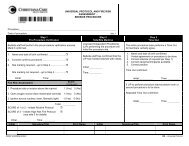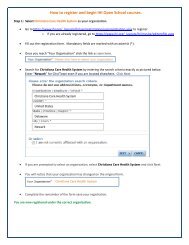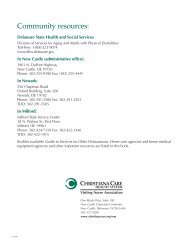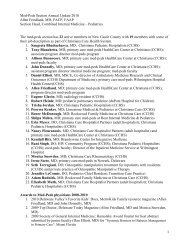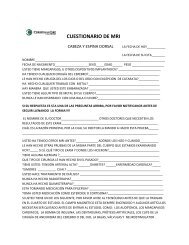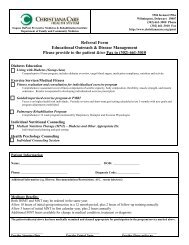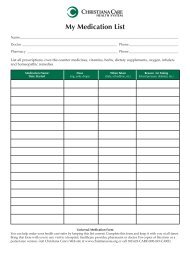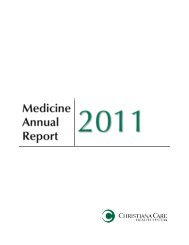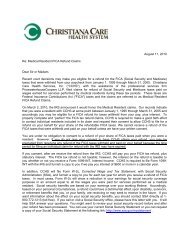Nutrition - Christiana Care Health System
Nutrition - Christiana Care Health System
Nutrition - Christiana Care Health System
You also want an ePaper? Increase the reach of your titles
YUMPU automatically turns print PDFs into web optimized ePapers that Google loves.
Good Fat – Bad Fat<br />
A special type of polyunsaturated fat known as<br />
omega-3 fats can be found in:<br />
■<br />
Fatty fish (such as salmon, mackerel, trout,<br />
tuna and sardines).<br />
Diets including omega-3 fats have been shown to<br />
lower heart disease risk. Aim for 2 three-ounce<br />
servings of fatty fish per week.<br />
Triglycerides<br />
What are triglycerides?<br />
Triglycerides are a form of fat found in the<br />
bloodstream that are composed of fatty acids<br />
and glycerol. They are completely different<br />
from cholesterol. When you eat a meal, your<br />
triglyceride level increases significantly, as it is<br />
a measure of any fat you have eaten. High levels<br />
of triglycerides combined with high cholesterol<br />
levels can increase your risk of coronary artery<br />
disease and heart attacks.<br />
How are triglyceride levels measured?<br />
A simple blood test is used to measure your<br />
triglyceride levels. It is very important that<br />
triglyceride readings be performed after a<br />
12 to 14 hour fast.<br />
For adults, fasting triglyceride levels should be<br />
less than 150 mg/dl. If the levels are higher,<br />
this signifies that you may be consuming too<br />
much sugary food, too many calories or fat, or<br />
excessive alcohol. Reduced physical activity,<br />
prediabetes and uncontrolled diabetes also can<br />
cause elevated triglycerides.<br />
What steps are necessary to lower<br />
triglyceride levels?<br />
1. Lose weight if you are overweight.<br />
Excess body weight can elevate triglyceride<br />
levels. Reduce portion sizes and increase<br />
intake of fresh fruits and vegetables.<br />
2. Exercise regularly.<br />
Engaging in physical activity for at least 30<br />
minutes most days of the week will raise HDL<br />
(good) cholesterol, help you to lose weight and<br />
lower triglyceride levels.<br />
3. Limit sweets.<br />
Cakes, cookies, fruit juice, soda and other<br />
sweetened items can raise triglyceride levels.<br />
4. Eat less saturated fat.<br />
Limit butter, red meat, regular cheese, whole milk<br />
and 2% milk. Choose poultry, fish, skim<br />
or 1% milk and low-fat cheese.<br />
5. Consume omega-3 fatty acids.<br />
Omega-3 fatty acids in doses of two to four grams<br />
per day can help to lower triglyceride levels. Good<br />
sources of omega-3 fatty acids include fatty fish, but<br />
these high doses generally require supplements. Be<br />
sure to consult your doctor first.<br />
6. Limit alcohol.<br />
Alcohol can stimulate the liver to produce<br />
triglycerides. Limit alcohol to one drink per day<br />
for women and two drinks per day for men.<br />
12




